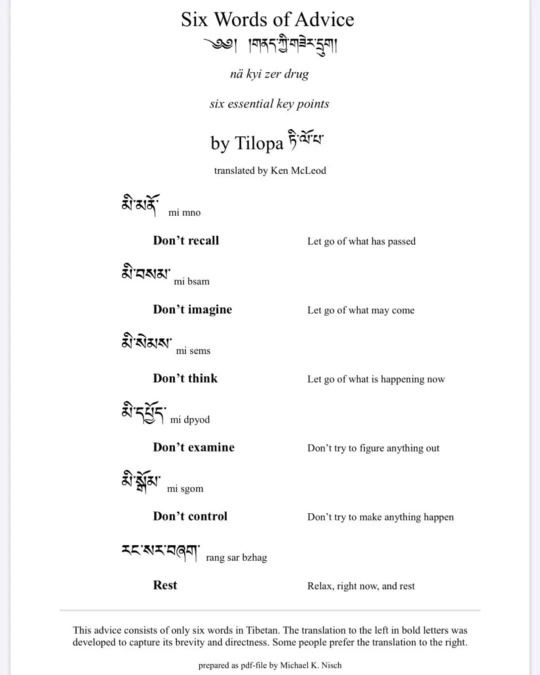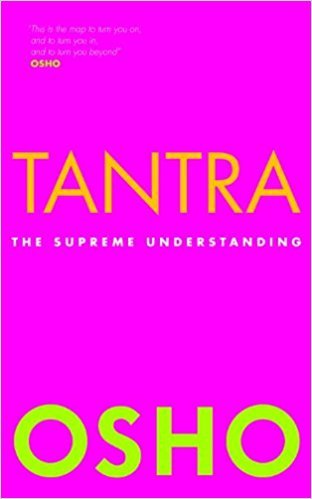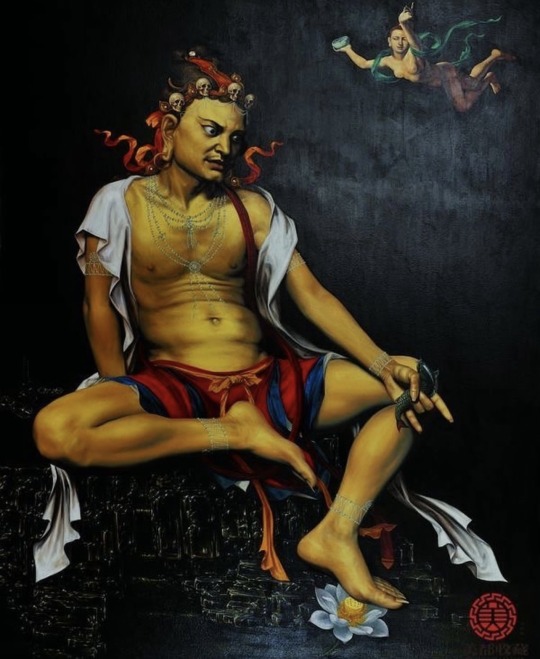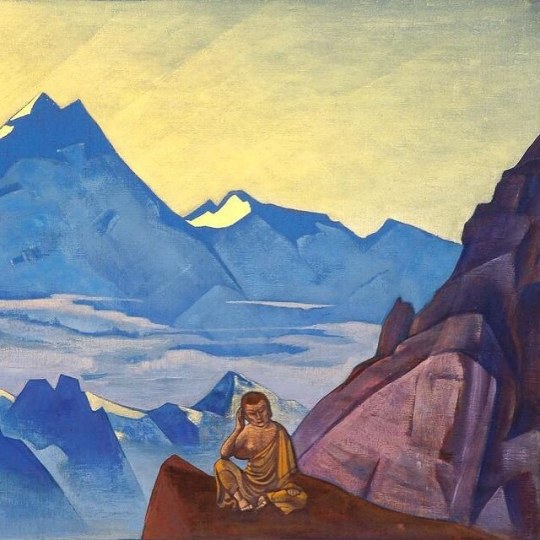#tilopa
Text
No thought, no reflection, no analysis, no cultivation, no intention; let it settle itself.
- Tilopa
32 notes
·
View notes
Text

Tilopa's Six Words of Advice
Don't recall - Let go of what has passed Don't imagine - Let go of what may come
Don't think - Let go of what is happening now
Don't examine - Do not try to figure out
Don't control - Do not try to make anything happen
Rest - Relax, right now, and rest
#buddha#buddhism#buddhist#dharma#sangha#mahayana#zen#milarepa#tibetan buddhism#thich nhat hanh#padmasambhava#inner peace#tilopa#Guru Rinpoche#Dzogchen
26 notes
·
View notes
Text

"At first a yogi feels his mind
Is tumbling like a waterfall;
In mid-course, like the Ganges
It flows on slow and gentle;
In the end, it is a great
Vast ocean, where the Lights
Of Son and Mother merge in one."
~ Tilopa
[Ian Sanders]
8 notes
·
View notes
Text
"Quien se aferra a la mente, no ve la verdad de lo que está más allá de la mente.
Quien se esfuerza en practicar el dharma, no encuentra la verdad que está más allá de la práctica.
Para conocer lo que está más allá de ambas, mente y práctica, uno debe cortar de raíz la mente y observarlo todo en total desnudez.
De esta forma, uno deja de lado toda distinción y permanece tranquilo"
Tilopa

Tilopa fue un gurú nacido en Bengala hoy Bangladesh en el año 988 de nuestra era. Llevó sus enseñanzas tántricas desde la India hasta el Tibet y se le atribuye el desarrollo de la doctrina mahamudra o método budista que conduce a la naturaleza propia de la mente estabilizada, no dual y sin apego.
Reconocido como fundador de una de las seis escuelas del Budismo Tibetano el denominado linaje Kagyu.
De acuerdo con algunas fuentes Tilopa nació en una familia real, la cual abandonó para adoptar una existencia errante de mendigo, recibiendo enseñanzas de diversos gurús a lo largo de su vida.
De acuerdo con una leyenda, se dice que recibió las enseñanzas del mahamudra directamente del Buda Vajradhara.
Se cuenta que Tilopa le dió seis consejos a su discípulo Naropa los cuales hablan de la mente liberada carente de tiempo, sin apegos ni juicios, como un medio para alcanzar el estado de Buda.
“Deja ir lo que ya pasó”, “Deja ir lo que pueda pasar”, “Deja ir lo que sucede ahora”, “No trates de interpretar nada”, “No trates de hacer que algo suceda”, “Relájate ahora y descansa”.
#citas de reflexion#budismo#tilopa#filosofia budista#cantos de tilopa#mahamudra#tibet#budismo tibetano#filosofía budista#notasfilosoficas#frases celebres
15 notes
·
View notes
Text

Let go of past
Let go of future
Let go of now
Let go of doing
Let go of doer-ship
Let go of searching
Let go of seeing outwards
Let go of seeing inwards
Let go of hearing outwards
Let go of hearing inwards
Let go of feeling outwards
Let go of feeling inwards
Let go of effort
Let go of control
Let go of the outcome
Let go of resistance
Let go of what was
Let go of what may come
Let go of what is
Let go, and rest
5 notes
·
View notes
Quote
Have a mind that is open to everything and attached to nothing.
Tilopa
4 notes
·
View notes
Text
Be Attentively Inattentive - Osho
This is what tantra says: the royal way – behave like a king, not like a soldier. There is nobody on top of you to force you and order you; there should not be really a style of life. That is the royal way. You should live moment to moment, enjoying moment to moment – spontaneity should be the way. And why bother about tomorrow? – This moment is enough. Live it! Live it in totality. Respond, but…

View On WordPress
0 notes
Text

https://www.thangkapaintings.com/tilopa-thangka.html
Tilopa was an Indian Buddhist monk in the tantric Kagyu lineage of Tibetan Buddhism.
988 - 1069
(Wikipedia)
0 notes
Text
Tantra
Tantra
The Supreme Understanding
Tantra:
The Supreme Understanding
Introduction
Tilopa’s Song of Mahamudra
A deep and insightful look into the underlying ideas of Tantra.
Walking the road to enlightenment by embodying the full acceptance of all that is. A commentary on Tilopa’s marvelous song.
Tilopa,
988–1069, was an Indian Buddhist monk in the tantric Kagyu lineage of Tibetan…

View On WordPress
1 note
·
View note
Text
Aforismi sulla meditazione – 4°
Aforismi sulla meditazione – 4°
La meditazione dovrebbe essere, per certi versi e per determinati gruppi d’individui, un esercizio metodico. Senonché, in un secondo momento, via via che si procede lungo l’incommensurabile via maestra della propria auto-realizzazione, il suo approfondimento sarà, in guisa del tutto spontanea, piuttosto progressivo. Seguono alcuni utili aforismi che ne chiariscono quei punti che, al momento, ci…

View On WordPress
#aforismi#concentrazione#Jasmuheen#Jiddu Krishnamurti#Kiribathgoda Gnanananda Thero#meditare#meditazione#Milarepa#Sheldon B. Kopp#Shunryu Suzuki Roshi#Sri Aurobindo#Thich Nhat Hanh#Tilopa#zen
0 notes
Text
Allow the polluted water of thoughts to clear. Neither negate nor affirm appearances, leave them as they are. If there is no rejecting or accepting, appearances and possibilities liberate as the mahamudra.
Mahamudra Upadesha
Mahasiddha Tilopa
13 notes
·
View notes
Text
No thought, no reflection, no analysis, no cultivation, no intention; let it settle itself.
Tilopa
16 notes
·
View notes
Text

-Yogi's Mind-
"At first a yogi feels his mind Is tumbling like a waterfall;
In mid-course, like the Ganges It flows on slow and gentle;
In the end, it is a great vast ocean,
Where the lights of son and mother merge in one."
- Mahasiddha Tilopa
#buddha#buddhist#buddhism#dharma#sangha#mahayana#zen#milarepa#tibetan buddhism#thich nhat hanh#tilopa
7 notes
·
View notes
Text

Image: "Milarepa, the One Who Harkened", Nicholas Roerich
* * * * *
“No thought, no reflection, no analysis, no cultivation, no intention; let it settle itself.”
~Tilopa
[h/t Ian Sanders]
7 notes
·
View notes
Text

The famous meditation master Tilopa once said to his student Naropa: "Son, it is not appearances that bind you, it is your Shenpa to them." Shenpa is a Tibetan term that refers to all the grasping and aversion we have to experience - all the push and pull.
So what Tilopa is suggesting, is that it is not the thoughts and emotions that rough you up, but rather all of our preferences and clinging
~ Elizabeth Mattis Namgyel
35 notes
·
View notes
Text

"True illuminates have no dreams. Dreams are for those who are asleep. True illuminates live in the higher worlds, out of the physical body, in a state of intensified wakefulness without ever dreaming." - Samael Aun Weor
Dream Yoga
The effort to awaken the consciousness in the dream state is called Dream Yoga. This term is most known from the tradition of Tilopa, Naropa, Marpa, and Milarepa, although the tradition of Niguma also includes Dream Yoga. Yoga comes from the Sanskrit word "yug," which means to "reunite" or "yoke together." This is the same as the root of our word religion, the Latin word "religare,"which means "to bind together." What is sought in both cases is the union of our consciousness with its source, but this can only happen when our consciousness is awakened and purified of all that is unclean.
The yogic tradition of Tilopa has been maintained in Tibetan Buddhism for hundreds of years. It is a series of teachings of which dream yoga is a vital part. It has been practiced and taught by all the Dalai Lamas, and such great initiates as Tsongkhapa and Milarepa.
The basic goal of Dream Yoga is to harness the power of the dream state and use it to awaken the consciousness. You can learn more about this by reading scriptures from the tradition.
26 notes
·
View notes